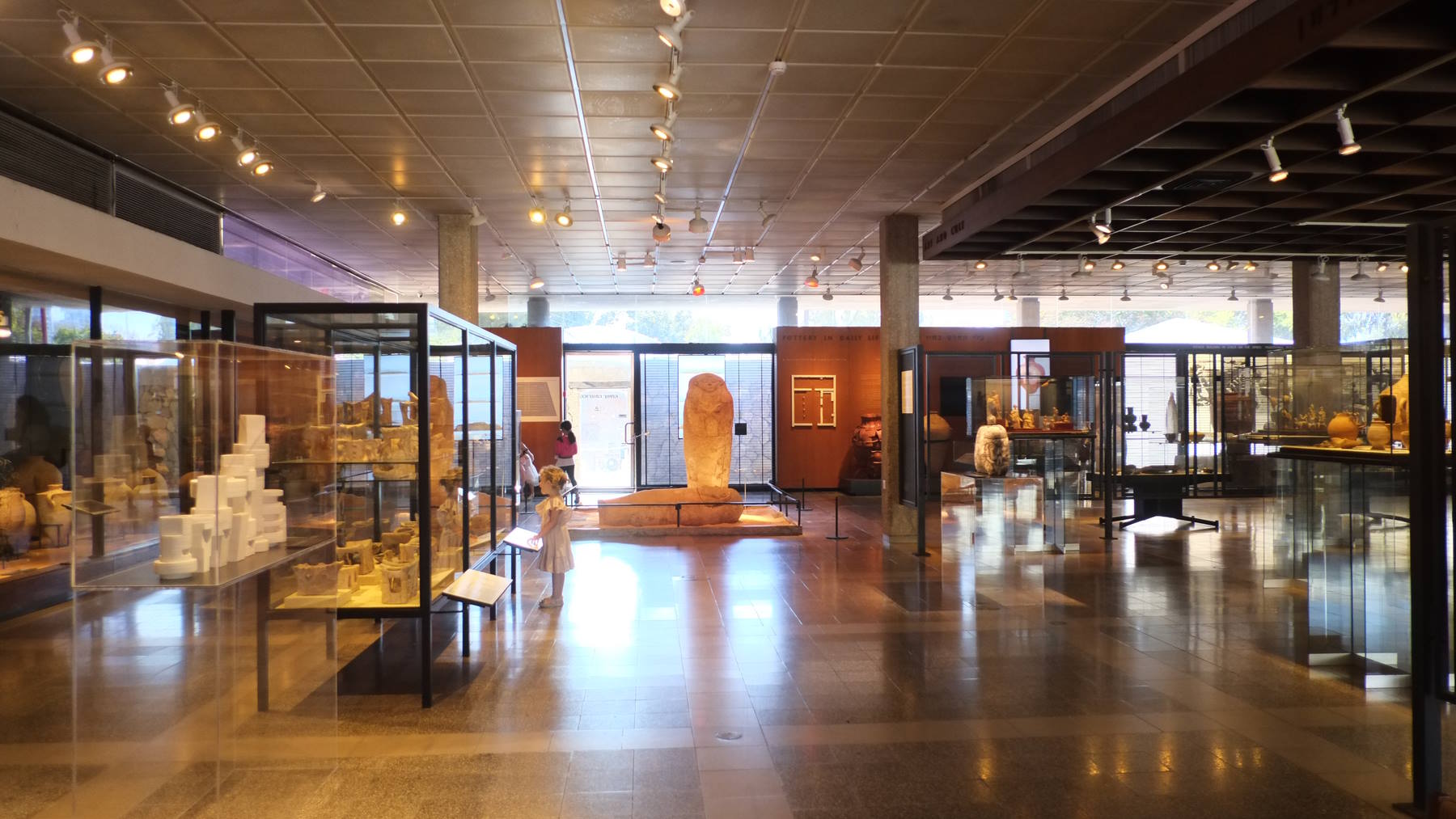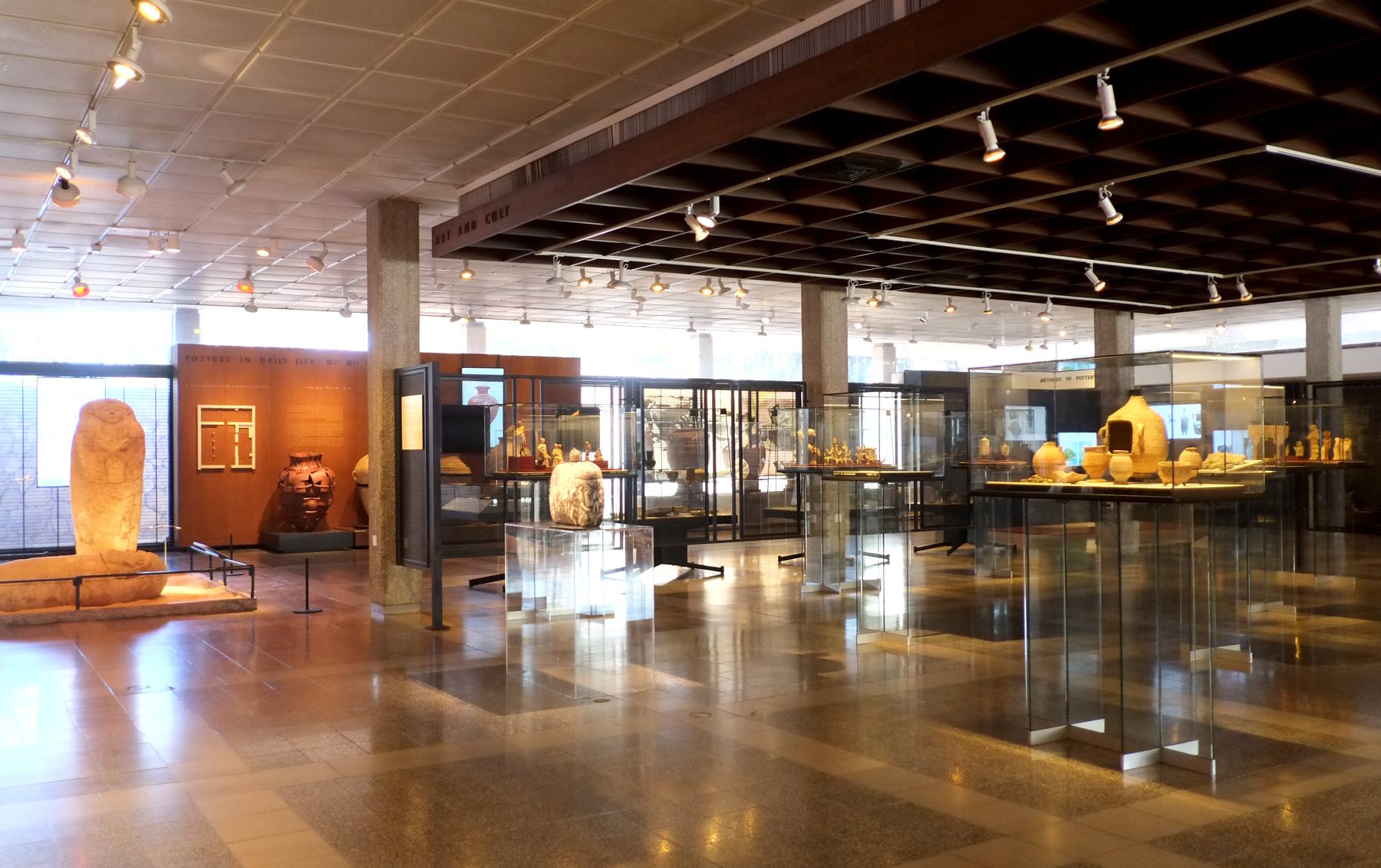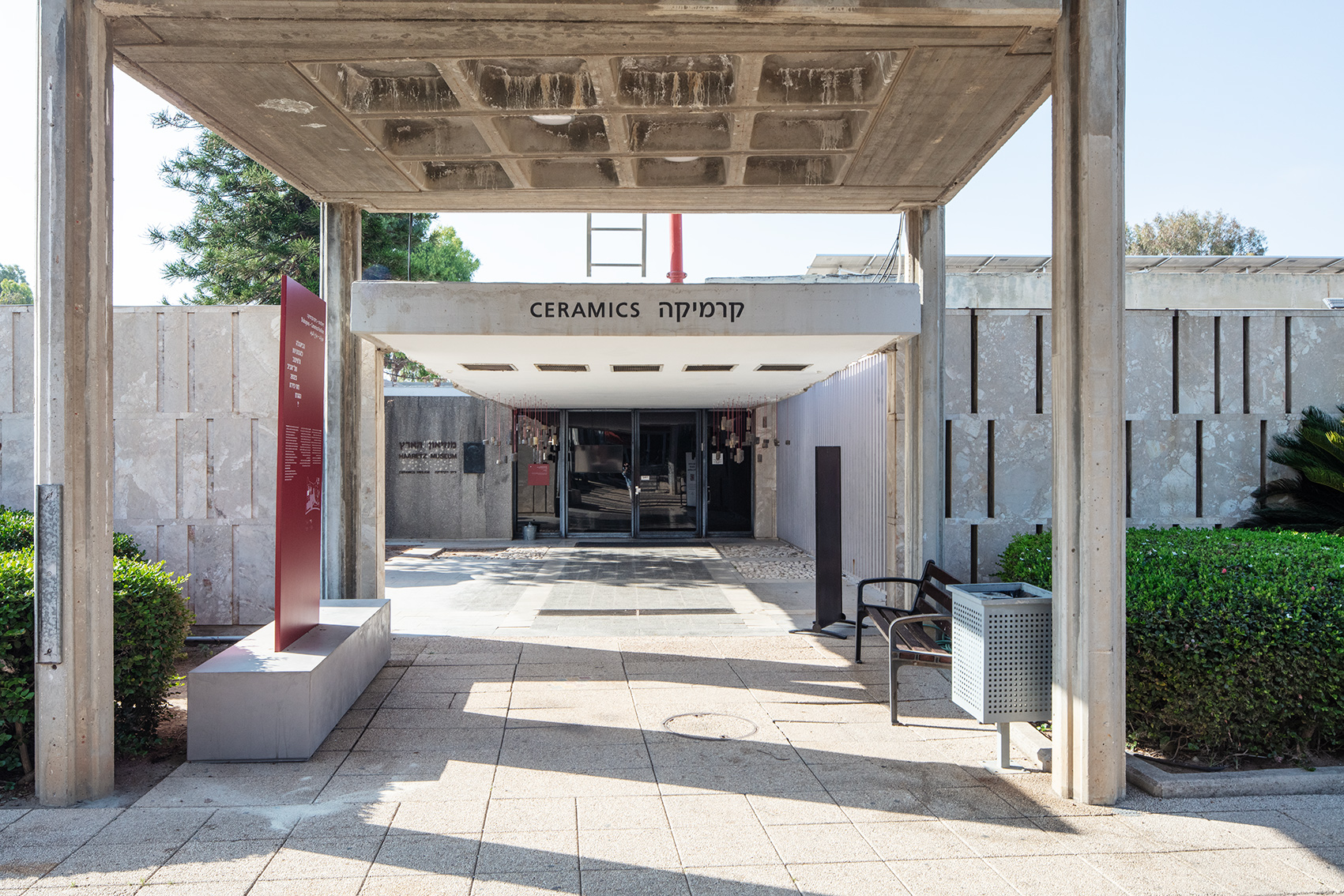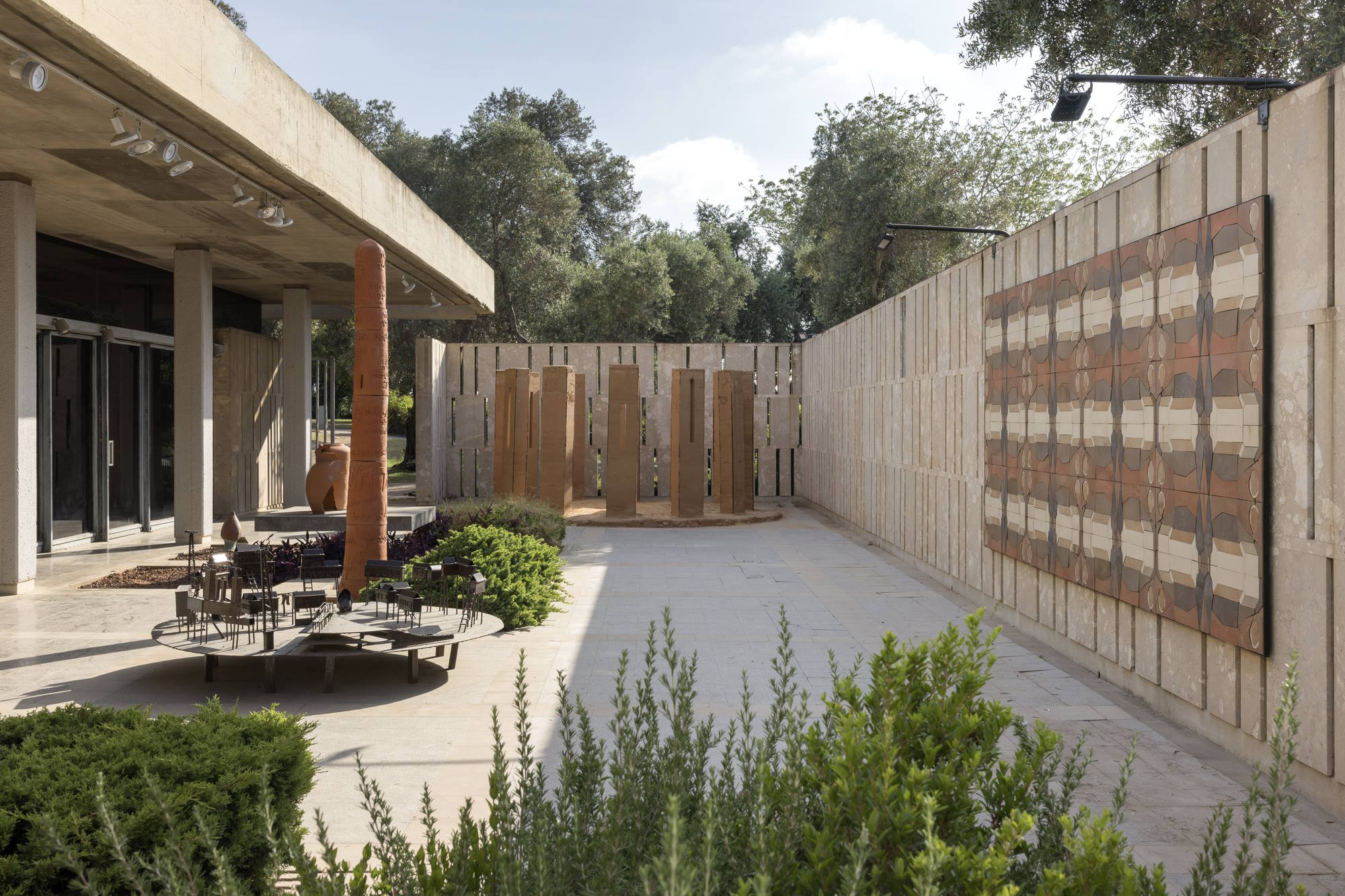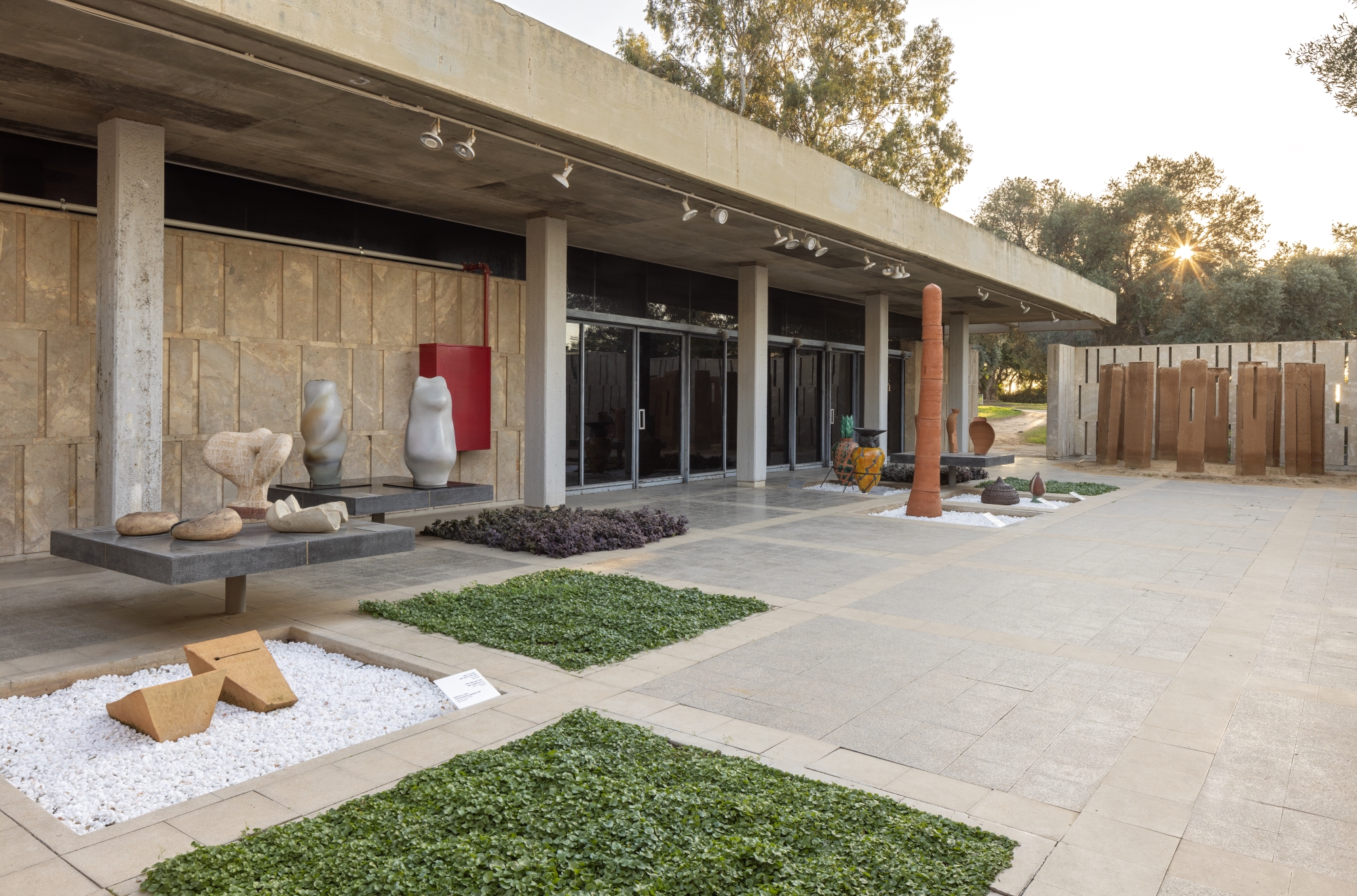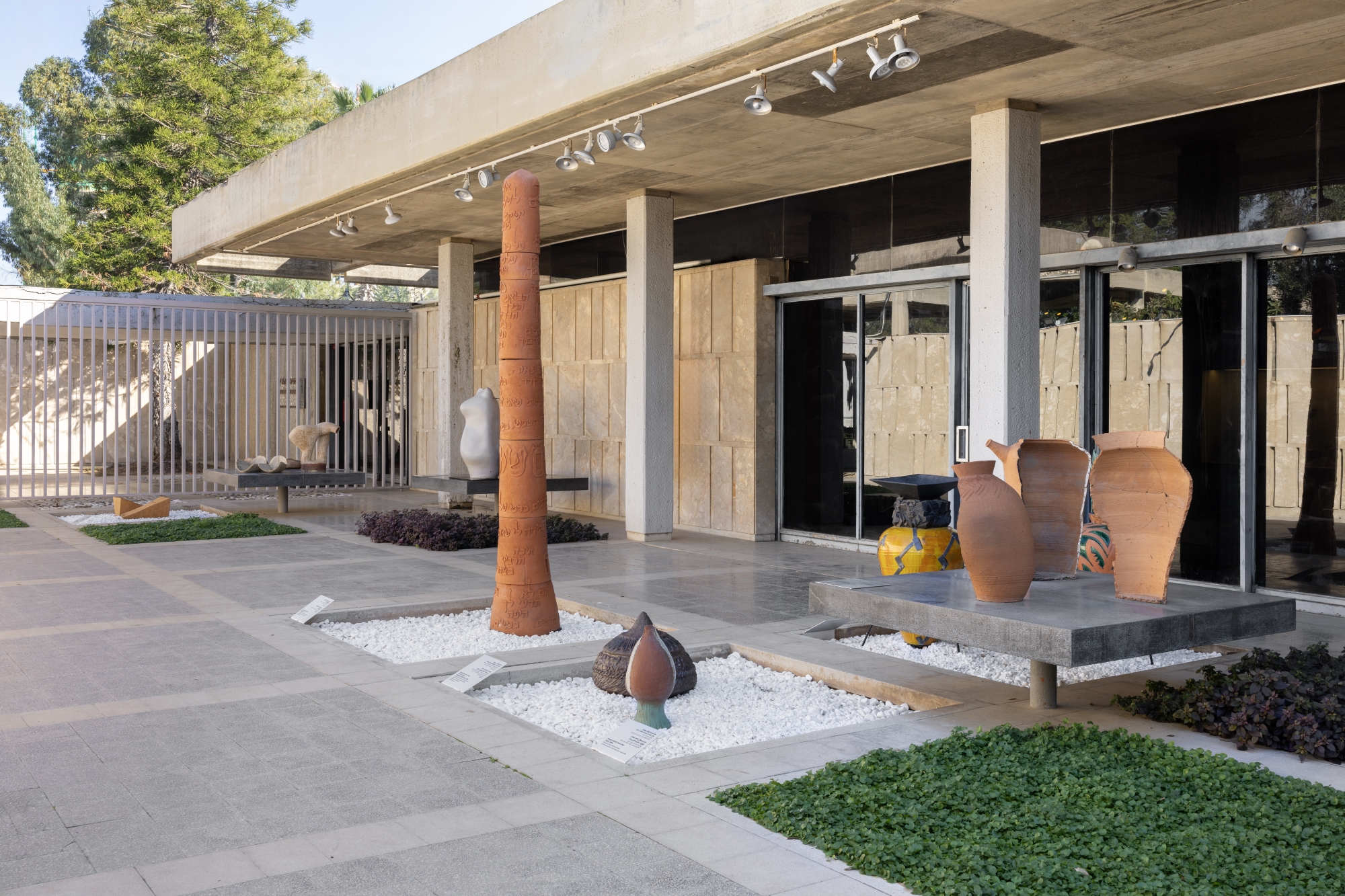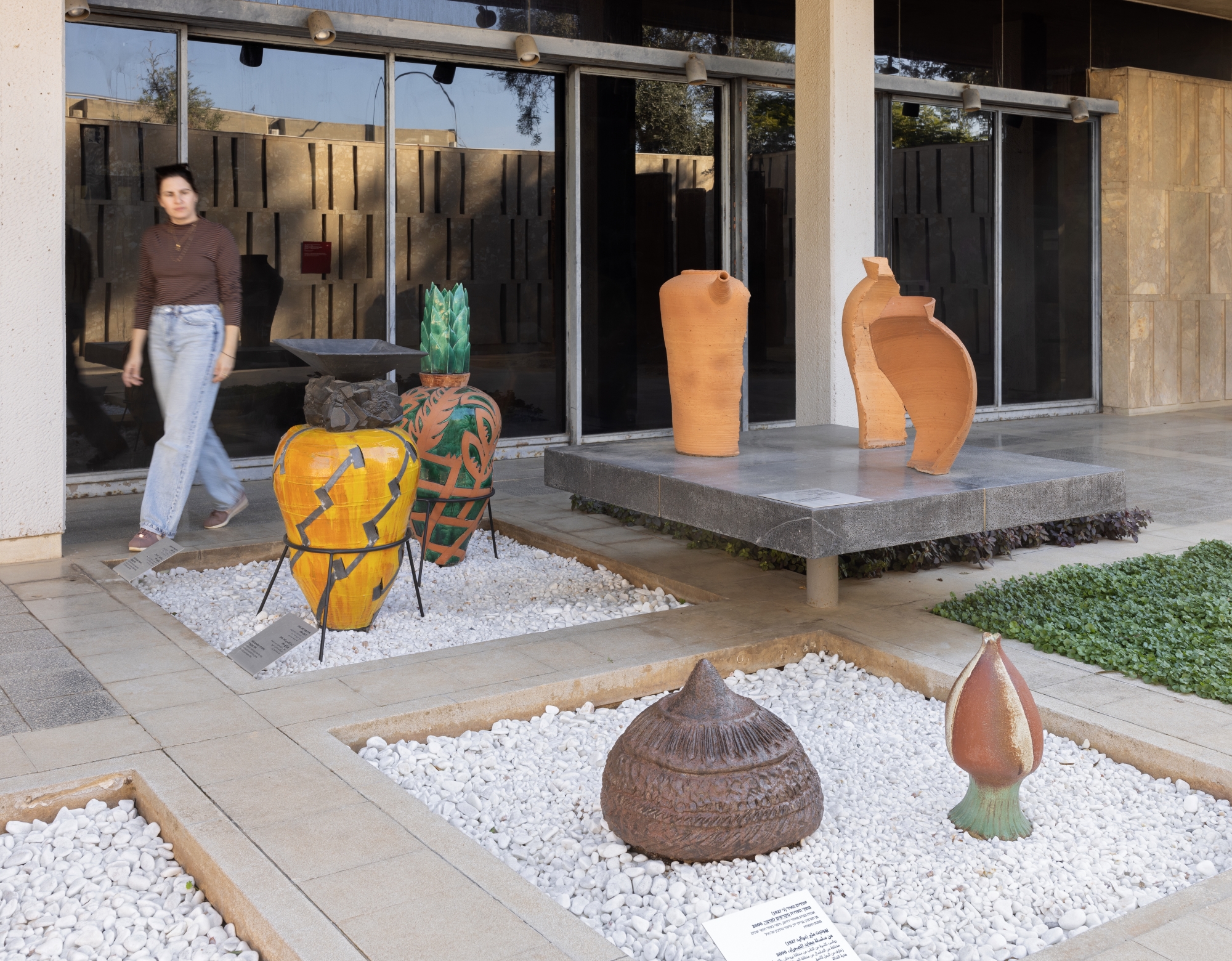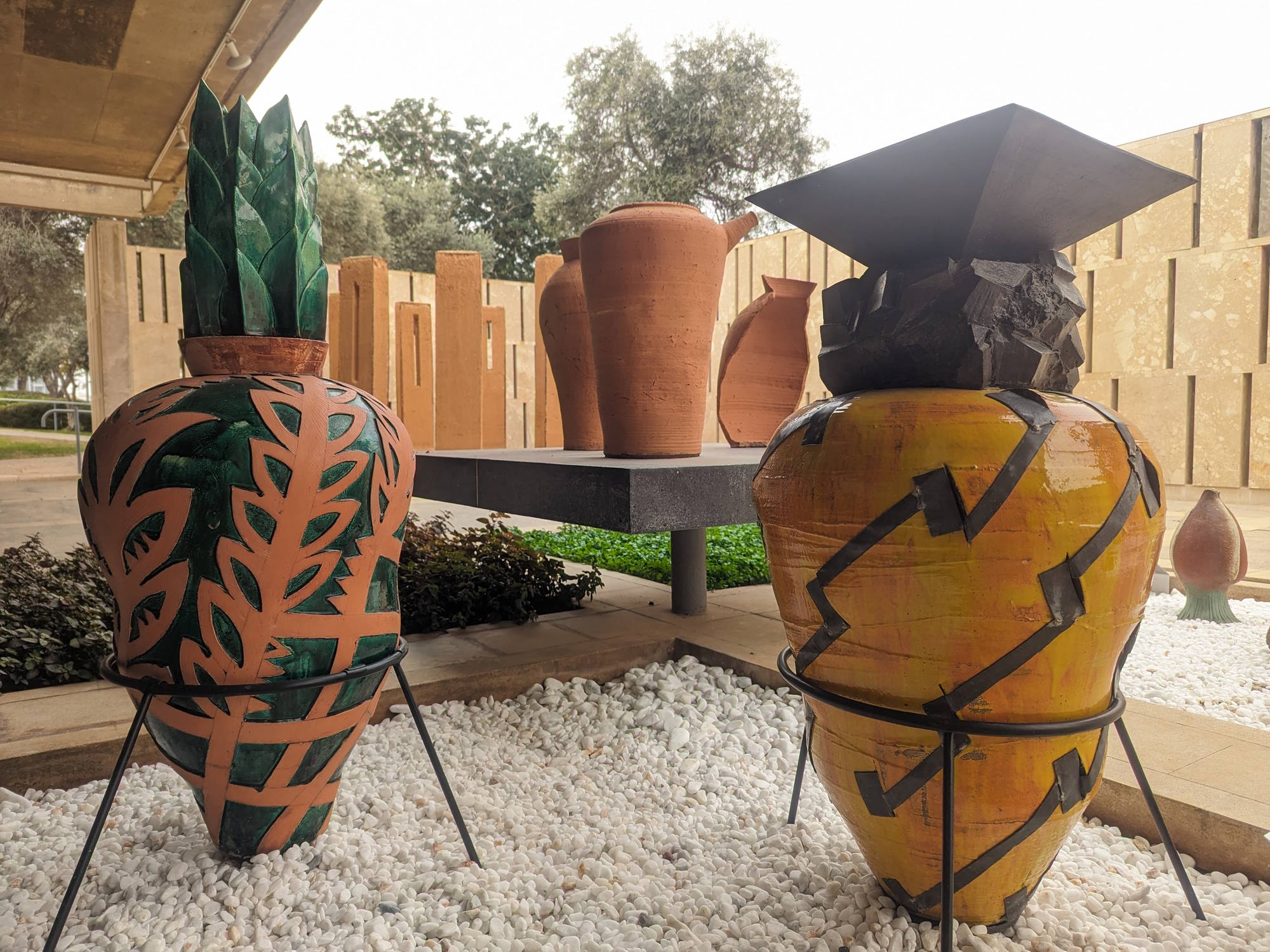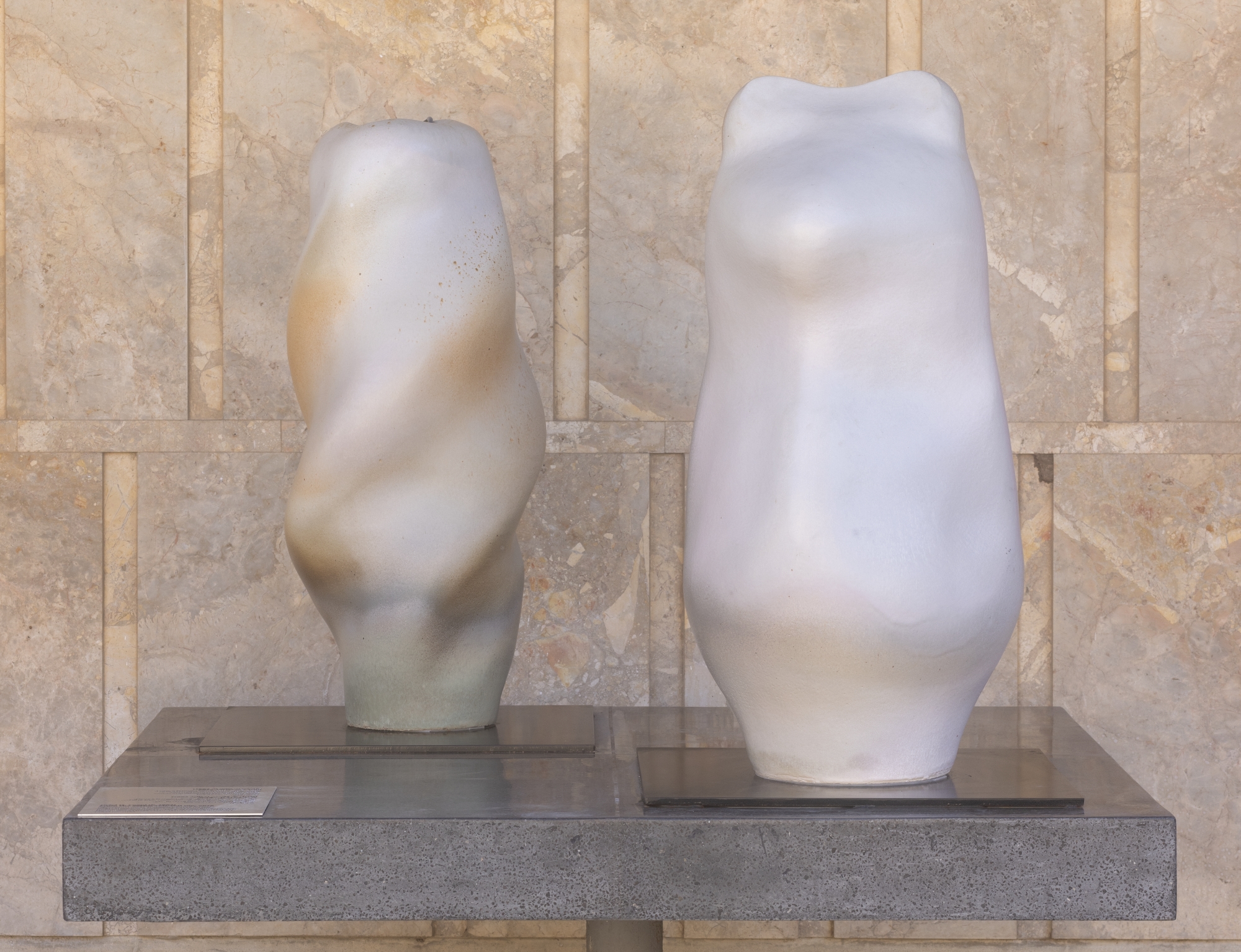The Ceramics Pavilion opened its doors to visitors in 1966. The building and the exhibit it contains are the joint work of top ranking architects, designers and archaeologists in 1950s-1960s Israel. The building was designed by the Wittkower-Baumann architecture firm to be in harmony with the characteristics of the local environment and climate. The architectural elements create a play of light and shadow on the building’s façades and shade the building while permitting the controlled entry of light and air. Local raw materials were also used to clad the building and the open courtyards. The internal exhibition space is open-plan, encouraging visitors to move around freely, and the large glass doors connect the outside to the inside while maintaining a division and separation between them.
The graphic design and the unique font used in the labels of the exhibit were the responsibility of Elisha Haimowitz and Noah Ophir. The font used in the pavilion, still known today as the “Ophir Font”, draws its inspiration from the ancient texts of the scrolls discovered in the Judean desert, given a modern interpretation. The architect Nahum Meron assisted in the internal design of the space and the actual exhibit.
The Exhibit
The exhibit in the pavilion is divided into seven sections presenting different aspects of ancient ceramic work, its products and their various uses. Scientific consultation for the exhibits was provided by the archaeologist Ruth Amiran, assisted by Yael Israeli and Pirhiya Beck.
The Discovery of Clay and the Dawn of Ceramics
The first use of fired clay about ten thousand years ago was a genuine revolution, since it freed humans from their exclusive dependence on materials found in nature in their raw form. Over the years the production process became more efficient and the use of ceramic vessels became central to human life. This part of the display presents items from the earliest use of fired clay vessels such as painted and decorated potsherds from the Neolithic period (Showcase 1), clay ossuaries (chests for secondary burial) from the Chalcolithic period (Platforms 4–5), and pottery vessels from the early Bronze Age (Showcase 3).
Pottery Manufacture Techniques
Various techniques have been used for pottery manufacture in different periods and regions, starting from production by hand and moving on to the use of the potter’s wheel, whose development changed the face of ceramics. Side by side along the western wall of the pavilion are displayed ancient pottery vessels and contemporary vessels from a range of cultures. This combination allows you to examine ancient manufacturing techniques and understand them via modern perspectives.
Decoration Methods
In this section are displayed vessels exemplifying different techniques used to decorate ceramics throughout history – glazing, burnishing, engraving, painting, and stamped decorations – which added an extra symbolic and aesthetic level to the plain vessels. Six showcases in the pavilion focus on this topic, and include vessels of the Tel el-Yahudiya style, one of which is decorated with a detailed hunting scene created by pricking and engraving (Showcase 12), as well as impressive Greek black-figure and red-figure vessels, in which the contrasting colors were created by a rigid control over the firing conditions (Showcase 14), and Islamic pottery with a special blue glaze which was very rare in antiquity (Showcase 16).
Ceramics and the Development of Writing
Among other things, ceramics were used as a writing surface. Clay tablets, vessels and potsherds (known as ostraca) are still being discovered at archaeological sites bearing rare inscriptions that assist researchers in the task of decoding the past. In this section you can see handles of the lamelekh type, which are evidence of the taxation and administration system of the First Temple period, Egyptian clay statuettes with ritual inscriptions and a clay brick that was part of a public building, on which appear the name and attributes of the Babylonian king Nebuchadnezzar.
Art and Ritual
In the center of the pavilion are displayed items from a range of periods and cultures that exemplify the ancient world’s symbolic and spiritual wealth. These items attest to the social and culture system in which the potter worked, and indirectly tell his story. Exhibited in this section is a small fraction of the repertoire of items uncovered in the sacred complex of Tell Qasile, such as the “Dancers cultic stand” (Showcase 24) and a libation vessel in the form of a woman with pierced breasts (Showcase 25).
The Use of Ceramics in the Study of Archaeology
This section demonstrates to the viewer how changes in the shapes and technologies of pottery vessels of different types over time help archaeologists distinguish different periods and learn about the connections between different regions and cultures in the ancient world. A look at the types of vessels on display in the show case – an oil lamp, a cooking pot or a jug – shows how their form developed over time and provides an introduction to the theory of typology in archaeological research, which allows researchers to classify groups of items, in this case ceramics, by type.
The Four-Room House / The Israelite House
This is a reconstruction of a type of structure discovered in Tell Qasile which in archaeological research known as “The Four-Room House”, or “the Israelite house”. A visit to the reconstructed building gives viewers a rare look into the dwellings of people living here 3,000 years ago, and its rooms provide examples of how ceramics were used in practice.
The Courtyard
Adjacent to the entrance of the Ceramics Pavilion is a small courtyard with a garden and an external space that serves as an extension of the display space inside the pavilion. The courtyard is surrounded by a wall of polished dolomite stones, punctuated by slits that invite passersby to peer inside. The architectural elements are both aesthetic and functional, while the use of local stone sourced from the Galilee ties the materials to the objects on display, which come from both the ancient and the contemporary local sphere.
Over the years, the courtyard has featured works by prominent local and international ceramic artists, such as Moshe Shek (Juke) and Hedwig Grossman Lehmann, as well as ceramic vessels painted by Picasso, Yehudit Meyer and Yocheved Marx, and others. The courtyard also served to display ancient vessels from the museum collection. As part of MUZA’s vision of renewal, the courtyard and its display were reopened in late 2023.
The renewed display includes two works by Lidia Zavadsky, T’ang Pot and Wine Jar, which express the centrality of the jar image in the work of local ceramic artists. Zavadsky, however, subjects the jars to such radical transformations that they relinquish their traditional functional values, becoming highly personal. Zavadsky was often inspired by Israel’s ancient material culture. In this case, one can note the influence of her work as a restorer of ancient ceramic fragments, which were found locally in archaeological excavations in the 1960s.
Also on display are works by Uriel Caspi that were part of his graduation project in the department of ceramic design and glass at Bezalel. His project, titled Tell/Tell Me, offers a personal interpretation of the archaeological term tel. Caspi gives concrete physical representation to the layers and strata that make up his personal universe. These works produce a modern archaeology, inviting viewers to explore Caspi’s world and the circles that surround him from his personal viewpoint.

